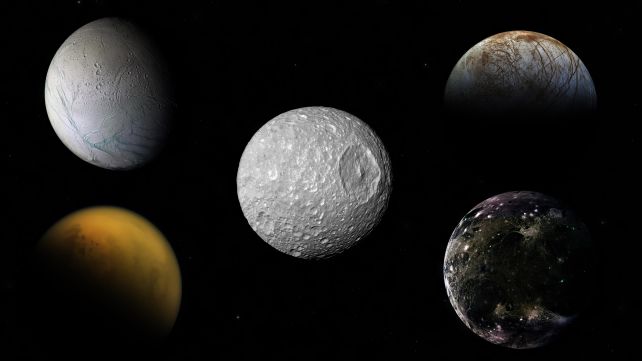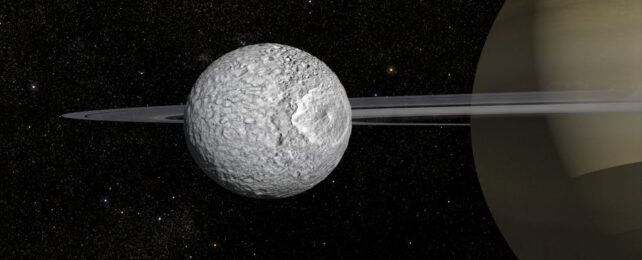New measurements of the orbit of Saturn's smallest major moon suggests there's a big secret lurking beneath its icy crust.
Mimas, whose cratered surface bears more than a passing resemblance to the Death Star from Star Wars, only makes sense if there's a liquid ocean swirling around 20 to 30 kilometers (12 to 19 miles) below the ice.
The new analysis, led by astronomer Valery Lainey of the Paris Observatory, is the latest in a growing body of evidence of a liquid ocean hiding inside the little moon.
That means that Mimas could join the long list of Solar System moons suspected of harboring liquid oceans, including Saturnian moon Enceladus, Jovian moons Europa, Callisto, and Ganymede, and several of the moons of Uranus. But Mimas is an oddity, and its ocean may be unlike any other in the Solar System.
As we grow better at understanding the cosmos, it has come to our attention that the Solar System is not as arid as it seems. Beneath their icy exteriors, many moons appear to be harboring hidden oceans.
But for a long time, Mimas was not thought to be among them. Fractured surfaces are thought to be a diagnostic criterion for secret oceans, such as the fissures that grace Enceladus and Europa. Mimas is unfissured, and heavily cratered to boot, so scientists thought that it must consist of solid ice, all the way down to the rocky core.
Yet the way the moon wobbles as it orbits Saturn hints that something a little hinky is going on out of view inside the 'Death Star' moon.

Modeling has previously suggested two different explanations: an elongated rocky core, or a global ocean. But the research by Lainey and his colleagues rule out the rocky core explanation pretty conclusively.
The team made a careful study of observations collected by the Cassini probe, which orbited Saturn between 2004 and 2017, collecting data on the planet and its moons at an unprecedented level of detail. Then, they conducted simulations to replicate the motion of Mimas as it orbits Saturn, reproducing the effects of a lop-sided core or ocean.
In order to reproduce the data under the rocky scenario, Mimas would need to have a core that is so elongated it's almost pancake-shaped in the direction of Saturn. This is utterly inconsistent with other observational data for the moon, as well as our models for the formation of Solar System bodies.
This leaves the hidden global ocean explanation. Given that we know these exist in the Solar System, it seems a lot more plausible.
Where it gets interesting is that the ocean appears to be very young.
The motion of Mimas, and the absence of signs of an ocean on its surface, suggest that the ocean is less than 25 million years old, and that the ice-ocean interface reached a depth of less than 30 kilometers just 2 to 3 million years ago.
So why did the ocean suddenly appear recently, when the Solar System is some 4.5 billion years old? Well, its formation requires internal heating, which in other moons is thought to be a result of an inconsistent gravitational interaction with other bodies. For most of the history of the Solar System, Mimas' orbit with Saturn could have been circular or almost circular, so that the gravitational interaction was fairly consistent.
However, if around 50 million years ago, an interaction with one or more of Saturn's other moons, such as Dione and Titan, pushed the moon's orbit into a more oval shape. This would cause a change in the strength of the gravitational interaction between Saturn and Mimas, placing stresses on the core that generate internal heating.
The findings reveal that we can't always make assumptions about what an ocean world will look like; or, in other words, you can't necessarily judge a moon by its crust.
And, because Mimas' ocean is so young, it can help us better understand how global oceans form, grow, and evolve.
"Mimas offers a unique opportunity to study ongoing melting-induced differentiation and extensive aqueous alteration driven by water-rock interactions," Lainey and his colleagues write.
"Mimas can thus provide a time window into the past evolution for Enceladus and other now-quiet icy worlds, including Uranian moons and Kuiper Belt objects. Aqueous mineral alteration in icy worlds is known to be geologically rapid, typically of the order of millions to tens of millions of years. Mimas would be one of the few places where this could happen right now."
The research has been published in Nature.
